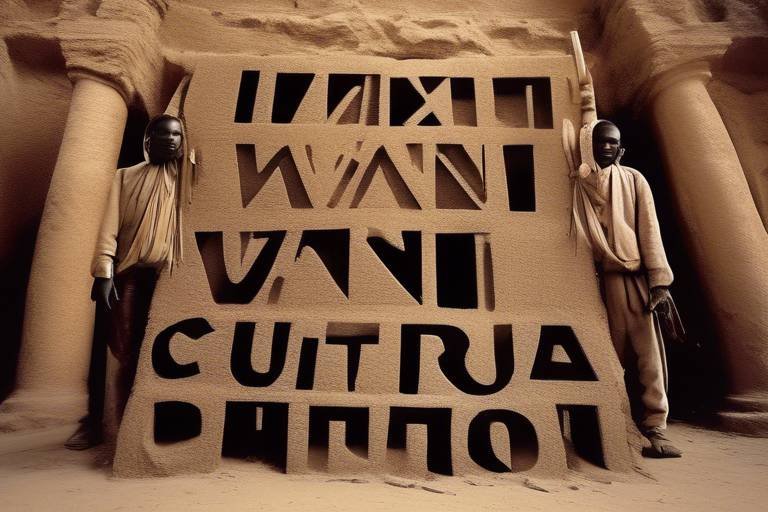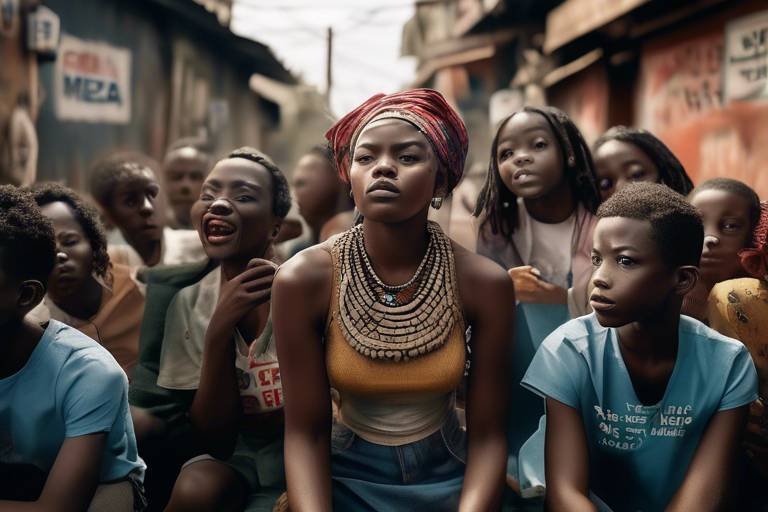The Impact of Technology on Cultural Preservation
The world we live in today is a vibrant tapestry of cultures, each with its own unique traditions, languages, and histories. However, as we race towards a digital future, the very essence of these cultures faces unprecedented challenges. Enter technology, a double-edged sword that can either aid in the preservation of our cultural identities or contribute to their decline. This article explores how technology influences cultural preservation, examining both the positive and negative effects on traditions, languages, and heritage. It highlights innovative methods and tools that aid in safeguarding cultural identities in a rapidly changing world.
Digital archiving plays a crucial role in preserving cultural artifacts and documents. Imagine walking into a museum where every exhibit is just a click away; this is the power of digital archiving. Technology enables the storage, accessibility, and sharing of historical materials, ensuring they are safeguarded for future generations. Through digitization, fragile documents and artifacts can be preserved in a format that is less susceptible to wear and tear. Furthermore, digital archives can be accessed by anyone, anywhere, promoting a global appreciation for diverse cultures. For instance, institutions like the Library of Congress have made vast collections available online, allowing people worldwide to explore their heritage without geographical constraints.
Imagine donning a VR headset and being transported to ancient Rome or the Great Wall of China. Virtual reality (VR) offers immersive experiences that allow users to engage with cultural heritage like never before. This technology can recreate historical sites and events, providing educational opportunities while fostering appreciation for diverse cultures. By stepping into these virtual worlds, individuals can witness cultural practices firsthand, making history come alive in a way that textbooks simply cannot. VR experiences can also be tailored to different audiences, ensuring that both young learners and seasoned historians find value in these digital explorations.
In today's interconnected world, social media platforms act as bridges, connecting individuals from different backgrounds. These platforms facilitate cultural exchange by promoting awareness of cultural practices, encouraging dialogue, and helping preserve traditions through shared experiences and stories. Consider how hashtags can spark global conversations about indigenous cultures or how TikTok has become a space for sharing traditional dances. These digital interactions not only celebrate diversity but also empower marginalized voices, ensuring that their stories are heard and valued. However, it’s essential to navigate these platforms carefully to avoid cultural appropriation and misrepresentation.
Language is a cornerstone of cultural identity, and with many languages facing extinction, technology steps in as a vital ally. Language preservation technologies, such as mobile apps and online resources, support language learning and documentation, ensuring linguistic diversity is maintained in the digital age. For example, platforms like Duolingo and Rosetta Stone have expanded their offerings to include endangered languages, making it easier for individuals to learn and engage with these languages. Additionally, initiatives like the Endangered Languages Project provide a space for communities to document their languages, creating a digital repository that future generations can access.
While technology aids preservation, it also presents challenges. Digital obsolescence, data loss, and the need for ongoing maintenance are significant concerns that must be addressed to ensure that cultural heritage remains accessible and intact over time. Just think about how quickly technology evolves; what was cutting-edge a decade ago may now be obsolete. Institutions must continually invest in updating their systems and training staff to manage these digital archives effectively. Moreover, the risk of cyber threats looms large, making it imperative to implement robust security measures to protect cultural treasures stored online.
Crowdsourcing initiatives leverage community involvement in cultural preservation efforts, creating a sense of ownership and pride among participants. Projects like Wikipedia and OpenStreetMap showcase how collaborative efforts can document and share cultural heritage. By empowering individuals to contribute their knowledge and experiences, these initiatives foster a deeper connection to cultural identities. Imagine a community coming together to document their local folklore or traditional recipes; this not only preserves their heritage but also strengthens communal bonds.
Globalization influences cultural preservation by introducing both challenges and opportunities. On one hand, it can dilute local cultures as global brands and trends overshadow traditional practices. On the other hand, technology can provide platforms for the promotion of these local cultures, allowing them to reach a broader audience. This interplay of cultural dynamics creates a complex landscape where preservation efforts must adapt to changing realities. For instance, social media can amplify local voices, enabling them to share their stories and traditions on a global stage.
Examining successful case studies reveals effective strategies for cultural preservation through technology. Projects like the Digital Public Library of America and Europeana have successfully integrated technology to safeguard and promote cultural heritage. These platforms not only provide access to vast collections of digitized materials but also engage users through interactive features, making cultural exploration more dynamic and enjoyable. By learning from these initiatives, future efforts can be better equipped to navigate the challenges of cultural preservation in a digital world.
The future of cultural preservation is shaped by ongoing technological advancements. As we look ahead, emerging tools and trends—such as artificial intelligence and blockchain technology—may further influence how cultures are preserved and celebrated in an increasingly digital world. These innovations could enhance the accuracy of digital records and provide secure methods for sharing cultural artifacts. By staying attuned to these developments, we can ensure that cultural preservation remains a priority in our rapidly evolving society.
- How does technology help in preserving cultural heritage?
Technology aids in preserving cultural heritage through digital archiving, virtual reality experiences, and language preservation tools, making cultural artifacts accessible to a global audience.
- What are some challenges of digital preservation?
Challenges include digital obsolescence, data loss, and the need for ongoing maintenance to ensure that cultural heritage remains intact over time.
- Can social media promote cultural exchange?
Yes, social media platforms facilitate cultural exchange by connecting individuals worldwide, promoting awareness of diverse cultural practices, and encouraging dialogue.

Digital Archiving
In today's fast-paced world, where information is constantly being generated and consumed, has emerged as a vital tool for preserving our cultural artifacts and documents. Imagine walking through a museum where every piece of history is not only displayed but also digitally stored, accessible to anyone with an internet connection. This is the power of digital archiving! It ensures that the stories of our past are not only preserved but also shared with future generations.
Digital archiving involves the process of converting physical documents, photographs, audio recordings, and other cultural materials into digital formats. This transformation not only safeguards these items from physical degradation but also enhances their accessibility. With just a few clicks, individuals can explore historical manuscripts, view ancient artifacts, or listen to traditional music from the comfort of their homes. The significance of this accessibility cannot be overstated; it democratizes knowledge and allows diverse audiences to engage with cultural heritage.
Furthermore, digital archiving plays a crucial role in the preservation of languages and traditions that might otherwise fade into obscurity. For instance, many indigenous languages are at risk of extinction, but through digital archiving, recordings of native speakers can be preserved and shared. This not only aids in language revitalization efforts but also fosters a sense of pride among communities, reminding them of their rich heritage.
However, the process of digital archiving is not without its challenges. The rapid evolution of technology means that formats can quickly become obsolete. A digital file saved today may not be accessible in a decade if the software or hardware used to read it becomes outdated. Therefore, ongoing maintenance and updates are essential to ensure that these digital treasures remain intact. Institutions must invest in regular audits and migrations of their digital collections to prevent data loss.
To illustrate the importance of digital archiving, consider the following table that highlights key benefits:
| Benefit | Description |
|---|---|
| Accessibility | Digital archives can be accessed from anywhere in the world, breaking geographical barriers. |
| Preservation | Physical items can deteriorate, but digital formats can be backed up and preserved indefinitely. |
| Engagement | Interactive digital experiences can enhance public interest and participation in cultural heritage. |
| Collaboration | Digital platforms enable institutions and communities to collaborate on preservation projects. |
In summary, digital archiving is not just about storing information; it's about creating a bridge between our past and future. It empowers individuals to explore their heritage, fosters educational opportunities, and helps ensure that the rich tapestry of human culture remains vibrant and accessible. As we continue to embrace technology, it is crucial that we also commit to preserving our cultural identities through innovative digital solutions.

Virtual Reality Experiences
Virtual reality (VR) is not just a buzzword; it's a revolutionary tool that has the potential to transform how we engage with cultural heritage. Imagine stepping into a meticulously recreated ancient city, walking through bustling markets, or witnessing historical events as if you were actually there. VR technology creates immersive experiences that allow users to connect with cultures in ways that were previously unimaginable. This innovative approach is not only about entertainment; it's about education and appreciation.
One of the most exciting aspects of VR is its ability to transport users to locations that may be physically inaccessible due to distance, conflict, or even natural disasters. For instance, a person living in a different country can explore the ruins of Pompeii or walk through the Great Wall of China without ever leaving their living room. This democratization of access to cultural heritage is profound, especially for those who may never have the opportunity to travel. By making these experiences available to a broader audience, VR fosters a greater understanding and respect for diverse cultures.
Moreover, VR can be a powerful educational tool. Imagine students in a classroom donning VR headsets to experience the history of the Egyptian pyramids or the intricacies of traditional Japanese tea ceremonies. This kind of immersive learning can significantly enhance retention and engagement. Studies have shown that experiential learning, such as that offered by VR, can lead to deeper understanding and appreciation of complex subjects, including culture and history.
However, it's essential to acknowledge that while VR offers numerous benefits, it also comes with challenges. The technology requires substantial investments in both hardware and software development. Not all cultural institutions have the resources to create high-quality VR experiences. Additionally, there is the question of authenticity. How do we ensure that the representations of cultures in VR are accurate and respectful? This highlights the importance of involving cultural experts and community members in the development process to create experiences that honor the traditions and histories being portrayed.
In summary, virtual reality is a groundbreaking tool for cultural preservation and education. By offering immersive experiences that connect users with diverse cultures, VR not only enhances learning but also promotes cultural appreciation. As technology continues to evolve, the potential for VR to play an even more significant role in cultural preservation is immense. The future may hold even more advanced experiences that can further bridge the gap between cultures, allowing us to explore and celebrate our shared human heritage.
- What is virtual reality? Virtual reality is a simulated experience that can be similar to or completely different from the real world. It often involves the use of VR headsets to immerse users in a 3D environment.
- How does VR help in cultural preservation? VR helps preserve culture by creating immersive experiences that educate users about different traditions, languages, and histories, making cultural heritage more accessible.
- Can anyone create VR experiences for cultural heritage? While technically anyone can create VR content, it's crucial to involve cultural experts to ensure accuracy and respect for the traditions being represented.
- What are the challenges of using VR for cultural preservation? Challenges include the high cost of technology, ensuring authenticity, and the need for ongoing maintenance and updates to the VR experiences.

Social Media and Cultural Exchange
In today’s interconnected world, social media serves as a powerful bridge that connects diverse cultures like never before. Imagine being able to share your grandmother's traditional recipes or your community's vibrant festivals with someone halfway across the globe! Social media platforms like Facebook, Instagram, and TikTok have transformed the way we interact with and appreciate cultural practices. They act as digital canvases where individuals can showcase their heritage, share stories, and engage in dialogue, fostering a rich tapestry of cultural exchange.
One of the most remarkable aspects of social media is its ability to promote awareness about cultural practices that might otherwise remain obscure. For instance, consider the hashtag movements that highlight specific cultural events or issues, such as #IndigenousPeoplesDay or #BlackHistoryMonth. These hashtags not only raise awareness but also encourage users to participate in discussions, share their experiences, and learn from one another. It’s like a global potluck where everyone brings their own unique dish to share, creating a feast of knowledge and understanding.
Moreover, social media can act as a repository for cultural traditions, helping to preserve them in a digital format. People can upload videos of traditional dances, songs, and storytelling sessions, ensuring these practices are not lost to time. For example, platforms like YouTube allow users to document and share their cultural events, creating a rich archive that future generations can access. This is particularly vital for cultures facing the threat of extinction, as it provides a way to keep their traditions alive, even in a rapidly changing world.
However, while social media fosters cultural exchange, it is not without its challenges. The rapid spread of information can sometimes lead to cultural appropriation, where elements of a culture are taken out of context or misrepresented. This can dilute the significance of cultural practices and lead to misunderstandings. Therefore, it’s crucial for users to approach cultural content with respect and a willingness to learn. Just as we wouldn’t walk into someone’s home and start rearranging their furniture, we should be mindful of how we engage with cultural content online.
To navigate these complexities, it’s essential to foster an environment of respect and understanding on social media platforms. This can be achieved through:
- Education: Encourage users to learn about the cultures they are engaging with.
- Respect: Acknowledge the origins of cultural practices and give credit where it’s due.
- Dialogue: Promote open conversations that allow for the sharing of perspectives and experiences.
In conclusion, social media has revolutionized cultural exchange, providing a platform for individuals to connect, share, and learn about each other's traditions. It’s a double-edged sword that requires careful handling, but when used thoughtfully, it can lead to a deeper appreciation of our world's rich cultural tapestry. By embracing the opportunities that social media presents, we can celebrate our differences while finding common ground.
Q: How does social media help in preserving cultural heritage?
A: Social media allows users to share videos, stories, and images of cultural practices, creating a digital archive that can be accessed by future generations.
Q: What are some risks associated with cultural exchange on social media?
A: Risks include cultural appropriation and misrepresentation, which can dilute the significance of cultural practices.
Q: How can individuals engage respectfully with other cultures on social media?
A: Individuals should educate themselves about the cultures they are engaging with, respect the origins of cultural practices, and promote open dialogue.

Language Preservation Technologies
In today's fast-paced digital landscape, are emerging as vital tools in the fight against the extinction of endangered languages. With over 7,000 languages spoken worldwide, many are at risk of disappearing as globalization and modernization take their toll. Fortunately, innovative technologies are stepping in to bridge the gap, ensuring that these unique linguistic treasures are not lost to time. Imagine a world where an endangered language can be spoken and learned through a simple app on your smartphone, or where native speakers can record their stories and share them with a global audience. This is not just a dream; it's becoming a reality.
One of the most impactful advancements in this field is the development of language learning apps. These applications, such as Duolingo and Rosetta Stone, are not only designed to teach popular languages but are also expanding their offerings to include less commonly spoken tongues. By gamifying the learning process, these apps make it accessible and engaging for users of all ages. For instance, a user can learn Hawaiian or Cherokee through interactive lessons that emphasize speaking and comprehension, thereby keeping these languages alive in a modern context.
Moreover, online resources have become invaluable in documenting and preserving languages. Websites like Endangered Languages Project provide a platform for researchers and community members to upload audio recordings, written texts, and videos. This collaborative effort ensures that even if a language is spoken by only a few individuals, its essence can be captured digitally for future generations. The importance of these resources cannot be overstated; they serve as a digital archive that can be accessed by anyone, anywhere in the world.
In addition to learning apps and online resources, social media has also played a pivotal role in language preservation. Platforms like Facebook and Instagram allow speakers of endangered languages to connect, share their culture, and promote their language through storytelling. For example, a community might create a group dedicated to sharing traditional tales in their native language, thus fostering a sense of pride and encouraging younger generations to embrace their linguistic heritage. The power of social media lies in its ability to create a sense of community, allowing individuals to engage with their culture in a meaningful way.
However, the journey of language preservation is not without its challenges. While technology offers incredible opportunities, it also raises questions about authenticity and ownership. Who gets to decide how a language is taught or documented? Are the voices of native speakers being prioritized, or is there a risk of outside influence overshadowing genuine cultural expression? These are crucial considerations that must be addressed as we move forward in the digital age.
In summary, language preservation technologies are revolutionizing the way we approach endangered languages. From mobile apps that teach and engage learners to online platforms that document and share cultural narratives, these tools are essential in the ongoing effort to keep languages alive. As we embrace these innovations, it’s crucial to remain mindful of the challenges they present, ensuring that the voices of native speakers are at the forefront of this movement. The question remains: how can we further harness technology to ensure that the world's linguistic diversity thrives for generations to come?
- What are language preservation technologies? These are tools and platforms designed to document, teach, and promote endangered languages, ensuring they are not lost over time.
- How do language learning apps help in preservation? They make learning endangered languages accessible and engaging, encouraging new speakers to emerge.
- Can social media really make a difference? Yes, it connects speakers and fosters community engagement, allowing for cultural exchange and storytelling.
- What challenges do these technologies face? Issues of authenticity, ownership, and the risk of outside influence are significant concerns that need to be addressed.

Challenges of Digital Preservation
In the digital era, while technology opens up exciting avenues for cultural preservation, it also presents a myriad of challenges that cannot be overlooked. One of the most pressing issues is digital obsolescence. Just think about it: how many times have you found an old file format that your current software can't read? This is a common scenario as technology evolves at a breakneck pace, rendering once-standard formats obsolete. If we’re not careful, crucial cultural artifacts could become inaccessible simply because the technology to read them no longer exists.
Another significant challenge is data loss. Imagine losing an entire archive of historical documents due to a hard drive failure or a cyber-attack. Unfortunately, this is not just a hypothetical situation; it happens more often than we’d like to admit. Institutions that hold valuable cultural information must invest in robust backup systems and security measures to protect against these threats. The cost of maintaining these systems can be daunting, especially for smaller organizations that may lack the resources.
Moreover, the need for ongoing maintenance is critical. Digital preservation is not a “set it and forget it” task. It requires continuous effort to ensure that files remain accessible and that technology keeps pace with changing standards. This means regularly updating software, migrating data to new formats, and ensuring that the hardware used to store this information remains functional. It's like maintaining a garden; if you neglect it, the weeds will take over, and before you know it, the beauty of your cultural heritage is lost.
Additionally, there’s the issue of equity in access. Not everyone has the same level of access to technology. In many parts of the world, communities may lack the resources needed to engage with digital preservation efforts. This creates a disparity where only certain cultures or histories are preserved, while others fade into obscurity. It's crucial to address these inequalities, ensuring that all voices are heard and all cultures are represented in the digital landscape.
Finally, we must consider the aspect of intellectual property rights. As we digitize cultural heritage, questions arise about who owns the rights to these digital assets. This can lead to conflicts between communities, institutions, and individuals, complicating the preservation process. Clear guidelines and ethical standards are necessary to navigate these murky waters effectively.
In summary, while technology offers incredible potential for preserving our cultural heritage, it is accompanied by significant challenges that require ongoing attention and innovation. Addressing these issues is vital to ensure that future generations can appreciate and learn from the rich tapestry of human culture.
- What is digital obsolescence? Digital obsolescence refers to the phenomenon where technology or file formats become outdated and inaccessible due to rapid advancements in technology.
- How can data loss be prevented? Data loss can be mitigated through regular backups, use of cloud storage, and maintaining updated security protocols.
- Why is ongoing maintenance important for digital preservation? Ongoing maintenance ensures that digital files remain accessible and relevant as technology evolves, preventing data from becoming obsolete.
- What are the challenges of equitable access in digital preservation? Equitable access challenges arise when certain communities lack the resources or technology to participate in digital preservation efforts, leading to disparities in representation.
- How do intellectual property rights affect cultural preservation? Intellectual property rights can complicate the preservation of cultural heritage by creating conflicts over ownership and access to digital assets.

Crowdsourcing Cultural Heritage
Crowdsourcing cultural heritage is an innovative approach that harnesses the collective power of communities to document, share, and preserve their unique traditions and histories. In an era where technology connects people like never before, this method allows individuals from diverse backgrounds to contribute their knowledge and experiences, creating a rich tapestry of cultural narratives. Imagine a world where your grandmother's recipe for traditional pie is just as important as a famous chef's culinary masterpiece. This is the essence of crowdsourcing—every voice matters, and every story counts.
One of the most remarkable aspects of crowdsourcing cultural heritage is its ability to foster a sense of ownership and pride among community members. When individuals participate in documenting their heritage, they become active stewards of their culture. This engagement not only helps preserve traditions but also encourages dialogue and understanding among different generations. For instance, digital platforms allow users to share oral histories, photographs, and artifacts, bridging the gap between the past and present. It's like building a virtual museum where everyone can contribute their unique artifacts and stories.
Several platforms have emerged that exemplify the power of crowdsourcing in cultural preservation. Projects like Historypin and Wikipedia allow users to upload historical images and narratives, creating a collaborative archive that is accessible to all. These initiatives often rely on the contributions of volunteers, who are motivated by a shared passion for their heritage. Not only do these platforms preserve cultural artifacts, but they also educate users about the significance of these items, enriching their understanding of cultural diversity.
However, it’s essential to recognize that crowdsourcing cultural heritage is not without its challenges. Issues such as the digital divide can limit participation, particularly among marginalized communities that may lack access to technology. Additionally, there are concerns about the authenticity of the information shared, as not all contributions may be accurate or respectful of cultural sensitivities. To mitigate these issues, many projects implement guidelines and community moderation to ensure that the content shared is both reliable and culturally appropriate.
In conclusion, crowdsourcing cultural heritage represents a powerful tool for preserving and celebrating the rich diversity of human culture. By empowering individuals to share their stories and artifacts, we create a more inclusive narrative that honors the past while paving the way for future generations. As technology continues to evolve, the potential for crowdsourced projects to enhance cultural preservation will only grow, inviting more voices to join the conversation. So, why not take part in this exciting journey? Your story might be the key to preserving a piece of history!
- What is crowdsourcing cultural heritage? Crowdsourcing cultural heritage involves gathering contributions from community members to document and preserve their traditions, stories, and artifacts.
- How can I participate in crowdsourcing cultural heritage? You can participate by joining platforms that focus on cultural documentation, sharing your stories, photographs, or artifacts, and engaging with others in your community.
- What are some challenges of crowdsourcing cultural heritage? Challenges include the digital divide, ensuring the accuracy of information, and maintaining respect for cultural sensitivities.
- Why is crowdsourcing important for cultural preservation? It empowers individuals, fosters community pride, and creates a more inclusive narrative that honors diverse cultural histories.

Impact of Globalization
The phenomenon of globalization has transformed the way cultures interact, leading to a complex interplay that can both enrich and challenge cultural preservation efforts. On one hand, globalization can act as a double-edged sword; it promotes the exchange of ideas and traditions across borders, but it can also threaten the very essence of local cultures. Imagine standing at a crossroads where the vibrant colors of traditional attire meet the sleek, modern aesthetics of global fashion—this is the reality many cultures face today.
As technology facilitates the rapid spread of information, cultural practices and expressions can reach a wider audience than ever before. For instance, social media platforms enable individuals from different backgrounds to share their customs, music, and art, fostering a sense of global community. However, this exposure can lead to the dilution of local traditions. When a cultural practice is adapted to fit a global audience, it may lose its authenticity. Think of it as a recipe that has been modified so many times that the original flavor is barely recognizable.
Moreover, the global marketplace encourages the commercialization of cultural elements. Traditional crafts may be mass-produced and sold as souvenirs, stripping them of their cultural significance. This commodification can create a sense of disconnection from the original meanings and practices. To illustrate this, consider the following table that outlines the potential benefits and drawbacks of globalization on cultural preservation:
| Benefits | Drawbacks |
|---|---|
| Increased awareness of diverse cultures | Risk of cultural homogenization |
| Access to global platforms for cultural expression | Commercialization of cultural practices |
| Collaboration across cultural boundaries | Loss of traditional knowledge and practices |
Despite these challenges, globalization also presents unique opportunities for cultural preservation. For example, many communities are using digital tools to document their traditions and languages, ensuring they are not lost in the tide of change. Online platforms allow for the sharing of cultural narratives, providing a space for voices that might otherwise go unheard. This has led to a resurgence of interest in local cultures, as younger generations seek to reconnect with their roots amidst a globalized world.
Ultimately, the impact of globalization on cultural preservation is a nuanced topic. It requires a careful balance between embracing new technologies and safeguarding traditional practices. As we navigate this ever-changing landscape, it’s essential to recognize the value of cultural diversity and the need for sustainable practices that honor both local and global influences. How can we ensure that our cultural heritage is not just preserved but celebrated in a way that respects its origins? This is a question that will continue to shape the future of cultural preservation as we move forward.
- How does globalization affect local cultures? Globalization can both promote cultural exchange and threaten local traditions by leading to homogenization and commercialization.
- Can technology help preserve endangered cultures? Yes, technology provides tools for documentation and sharing, allowing communities to maintain their cultural identities.
- What role do social media platforms play in cultural preservation? Social media facilitates cultural exchange and awareness, helping to promote and preserve traditions through shared experiences.

Case Studies of Successful Initiatives
When we talk about the intersection of technology and cultural preservation, it's not just theory; there are real-world examples that showcase the incredible potential of innovative initiatives. One standout example is the Digital Himalaya Project, which aims to preserve the cultural heritage of the Himalayan region. By digitizing a vast collection of documents, photographs, and audio recordings, this project ensures that the rich traditions and languages of the area are not lost to time. Imagine being able to explore the songs, stories, and histories of a culture that spans millennia, all from the comfort of your home. This project not only safeguards these materials but also makes them accessible to researchers and the public alike, fostering a deeper understanding of the region's unique cultural tapestry.
Another inspiring initiative is the Endangered Languages Project, which focuses on documenting and revitalizing languages that are on the brink of extinction. The project utilizes a combination of community engagement and technology to create a platform where speakers of endangered languages can contribute resources, share knowledge, and connect with others. This is crucial because language is more than just a means of communication; it embodies the essence of a culture. By leveraging technology, this initiative empowers communities to take ownership of their linguistic heritage, ensuring that future generations can continue to speak and celebrate their ancestral tongues.
In the realm of virtual reality, the Virtual Reality Heritage Project has made waves by recreating historical sites and cultural experiences. For instance, users can take a virtual tour of ancient ruins or participate in traditional ceremonies from cultures around the world. This immersive experience not only educates but also fosters a sense of appreciation for diverse cultures. Imagine stepping into a VR world where you can walk through the streets of ancient Rome or experience a traditional dance in a remote village. Such experiences can bridge the gap between cultures, creating empathy and understanding in a way that textbooks simply cannot.
Moreover, the UNESCO Memory of the World Programme serves as a global initiative to preserve documentary heritage. By recognizing important documents and archives that hold significant cultural value, UNESCO helps to ensure their protection and accessibility. For instance, the Magna Carta, a cornerstone of modern democracy, is preserved under this initiative, allowing people from all over the world to connect with its historical importance. Through this program, we see how global collaboration can lead to the safeguarding of cultural legacies that resonate across borders.
Lastly, the Smithsonian's Digitization Program exemplifies how major institutions are embracing technology to enhance cultural preservation. By digitizing millions of artifacts, photographs, and documents, the Smithsonian not only protects these treasures but also makes them available to a global audience. This initiative democratizes access to cultural heritage, allowing anyone with an internet connection to explore the depths of American history and beyond. It’s like having a front-row seat to a vast museum, where every click opens a new chapter of discovery.
These case studies highlight the diverse approaches being taken to leverage technology in the pursuit of cultural preservation. Whether through digital archiving, immersive virtual experiences, or community-driven initiatives, the potential for innovation is boundless. As we continue to navigate the complexities of our modern world, these successful initiatives remind us that technology can be a powerful ally in safeguarding our cultural identities for generations to come.
- What is digital archiving? Digital archiving refers to the process of converting physical documents and artifacts into digital formats to ensure their preservation and accessibility.
- How does virtual reality contribute to cultural preservation? Virtual reality allows users to experience and engage with cultural heritage in immersive ways, providing educational opportunities and fostering appreciation for different cultures.
- Why is language preservation important? Language preservation is vital because languages carry unique cultural identities and histories. When a language dies, a part of its culture and heritage is lost.
- What are some challenges in digital preservation? Challenges include digital obsolescence, data loss, and the need for ongoing maintenance to ensure accessibility and integrity over time.
- How can individuals contribute to cultural preservation? Individuals can participate in crowdsourcing initiatives, share their cultural stories online, or engage with local preservation efforts to help document and celebrate their heritage.

The Future of Cultural Preservation
The future of cultural preservation is a fascinating landscape shaped by rapid technological advancements and innovative methodologies. As we stand on the brink of a digital revolution, it’s essential to consider how these changes will influence the ways we safeguard our cultural heritage. Imagine a world where every tradition, language, and artifact can be preserved and accessed at the click of a button. Sounds exciting, right? This is not just a fantasy; it’s becoming a reality thanks to emerging technologies.
One of the most promising avenues for the future is the integration of Artificial Intelligence (AI) in cultural preservation. AI can analyze vast amounts of data, helping to identify patterns and connections that may have gone unnoticed. For instance, AI-driven tools can assist in the restoration of damaged artifacts by predicting what they might have looked like before deterioration. This technology not only enhances our understanding of historical items but also ensures that they can be appreciated by future generations in their original glory.
Moreover, the rise of Blockchain technology offers a revolutionary approach to preserving cultural heritage. By creating immutable records of ownership and provenance, blockchain can help protect cultural artifacts from theft and illicit trade. This technology ensures that the stories behind each piece are securely documented, fostering a deeper appreciation for their cultural significance. Imagine tracing the journey of an artifact through time, knowing exactly where it has been and who has cared for it.
In addition to AI and blockchain, the future will likely see more collaborative platforms that engage communities in cultural preservation efforts. These platforms can serve as digital gathering spaces where individuals share their stories, traditions, and artifacts. By fostering a sense of community and ownership, these initiatives can empower people to actively participate in preserving their cultural identities. It’s akin to building a virtual museum where everyone can contribute to the narrative of their heritage.
Furthermore, advancements in Augmented Reality (AR) could transform how we experience cultural heritage. Imagine walking through a historical site and using your smartphone to see how it looked centuries ago, or interacting with virtual representations of historical figures. AR can provide immersive experiences that educate and engage people, making cultural heritage more accessible and exciting for younger generations.
However, it’s crucial to remember that while technology offers incredible opportunities, it also poses challenges. As we embrace these tools, we must ensure that we do not lose the essence of what makes cultural preservation meaningful. The human connection to our heritage is irreplaceable, and technology should serve as a bridge, not a barrier. We need to strike a balance between leveraging technology and maintaining the authenticity of cultural experiences.
As we look ahead, the future of cultural preservation is not just about the tools we use but also about the mindset we adopt. Embracing a holistic approach that incorporates technology, community involvement, and respect for cultural narratives will be essential. By fostering collaboration between technologists, cultural practitioners, and local communities, we can create a sustainable framework for preserving our diverse cultural landscapes.
In conclusion, the future of cultural preservation is bright, filled with possibilities that can enhance our understanding and appreciation of heritage. With the right tools and a collaborative spirit, we can ensure that our cultural identities are not only preserved but celebrated in ways that resonate with future generations. The journey ahead is exciting, and we all have a role to play in shaping how our cultures are remembered and cherished.
- What role does technology play in cultural preservation?
Technology aids in documenting, restoring, and sharing cultural artifacts and traditions, making them more accessible to a wider audience. - How can AI assist in preserving cultural heritage?
AI can analyze data related to cultural artifacts, helping with restoration efforts and identifying historical connections. - What are some challenges associated with digital preservation?
Challenges include digital obsolescence, data loss, and the need for ongoing maintenance to keep cultural materials accessible. - Can social media contribute to cultural preservation?
Yes, social media platforms facilitate cultural exchange and awareness, allowing individuals to share their traditions and stories globally.
Frequently Asked Questions
- How does technology aid in cultural preservation?
Technology plays a pivotal role in cultural preservation by enabling the digital archiving of artifacts, documents, and traditions. It allows for the safe storage and easy accessibility of cultural materials, ensuring they can be shared and appreciated by future generations. Through innovative tools, we can document languages, traditions, and historical events, making them available to a global audience.
- What is digital archiving and why is it important?
Digital archiving is the process of converting physical artifacts and documents into digital formats for preservation. This is crucial because it protects against physical degradation and loss while making cultural heritage accessible to anyone with an internet connection. It ensures that even if original items are damaged or lost, their digital counterparts remain intact for educational and cultural purposes.
- Can virtual reality really help in experiencing cultural heritage?
Absolutely! Virtual reality (VR) provides immersive experiences that transport users to historical sites and events. It allows individuals to engage with cultural heritage in a way that traditional methods cannot. By recreating environments and experiences, VR fosters a deeper appreciation and understanding of diverse cultures, making learning about history more engaging and impactful.
- How do social media platforms contribute to cultural exchange?
Social media platforms act as bridges connecting people from different cultures, facilitating the sharing of stories, traditions, and practices. They promote awareness and dialogue, allowing users to celebrate their heritage while learning about others. This exchange fosters a global community that values cultural diversity and encourages the preservation of traditions through shared experiences.
- What technologies are used for language preservation?
Language preservation technologies include apps, online courses, and resources that support learning and documenting endangered languages. These tools help maintain linguistic diversity by making learning accessible and engaging. By utilizing technology, communities can revitalize their languages and ensure they are passed down to future generations.
- What challenges does digital preservation face?
While digital preservation offers many benefits, it also comes with challenges such as digital obsolescence, where older formats become unreadable, and data loss due to technical failures. Ongoing maintenance and updates are essential to ensure that cultural heritage remains accessible and intact over time, requiring commitment and resources to address these issues effectively.
- How can crowdsourcing help in cultural preservation?
Crowdsourcing empowers communities to actively participate in documenting and sharing their cultural heritage. By involving individuals in preservation efforts, it fosters a sense of ownership and pride in their traditions. Collaborative projects can lead to rich, diverse collections of cultural materials that reflect the community's unique identity and history.
- What is the impact of globalization on cultural preservation?
Globalization presents both challenges and opportunities for cultural preservation. While it can dilute local cultures by promoting homogenization, it also provides platforms for cultural promotion and exchange. Technology can help local cultures thrive by allowing them to reach wider audiences, creating a complex interplay of cultural dynamics that can benefit preservation efforts.
- Can you provide examples of successful cultural preservation initiatives?
Sure! There are many successful initiatives that have integrated technology into cultural preservation. For instance, projects that utilize 3D scanning to document artifacts or online platforms that host virtual exhibits have proven effective. These case studies highlight innovative strategies that can inspire future efforts in safeguarding cultural heritage.
- What does the future hold for cultural preservation with technology?
The future of cultural preservation is bright, with ongoing technological advancements shaping how we safeguard and celebrate cultures. Emerging tools such as augmented reality, AI-driven documentation, and enhanced digital platforms are expected to further influence preservation methods, making cultural heritage more accessible and engaging in an increasingly digital world.



















